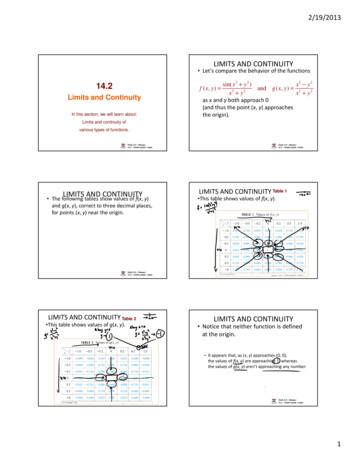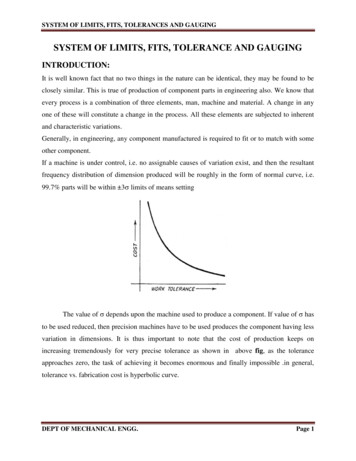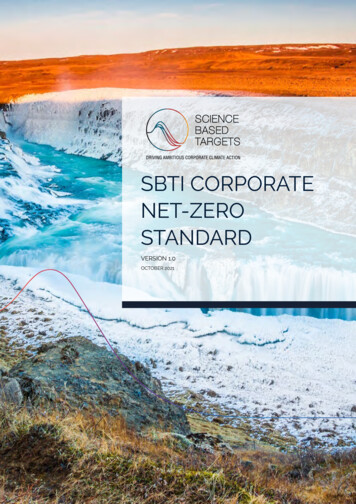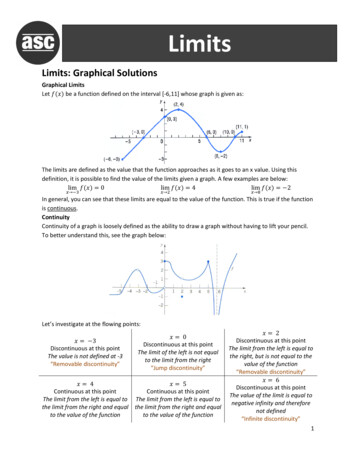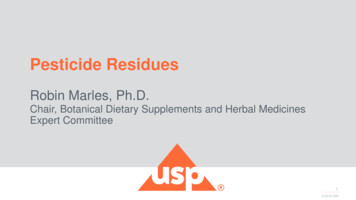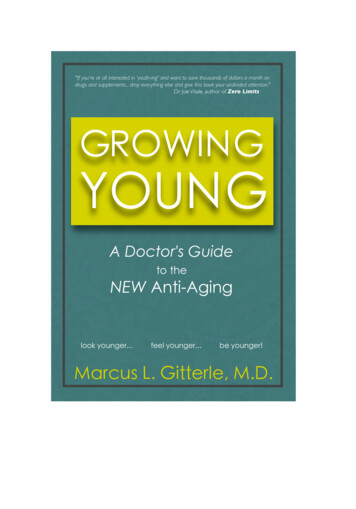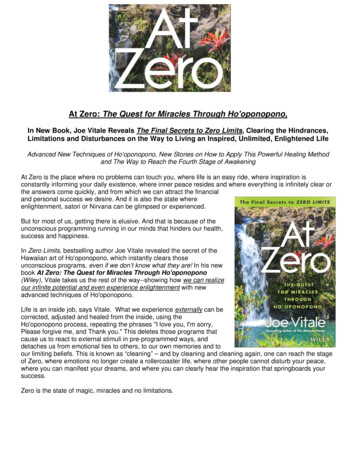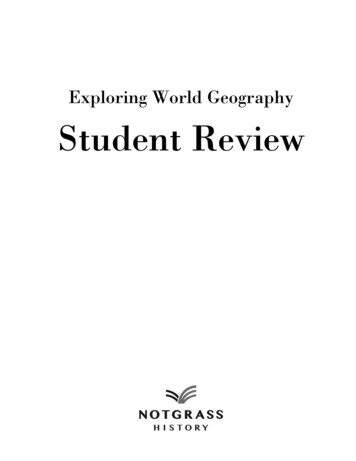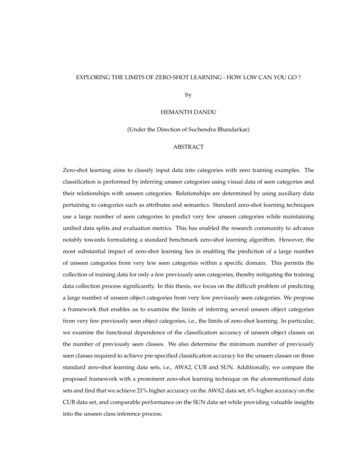
Transcription
EXPLORING THE LIMITS OF ZERO-SHOT LEARNING - HOW LOW CAN YOU GO ?byHEMANTH DANDU(Under the Direction of Suchendra Bhandarkar)ABSTRACTZero-shot learning aims to classify input data into categories with zero training examples. Theclassification is performed by inferring unseen categories using visual data of seen categories andtheir relationships with unseen categories. Relationships are determined by using auxiliary datapertaining to categories such as attributes and semantics. Standard zero-shot learning techniquesuse a large number of seen categories to predict very few unseen categories while maintainingunified data splits and evaluation metrics. This has enabled the research community to advancenotably towards formulating a standard benchmark zero-shot learning algorithm. However, themost substantial impact of zero-shot learning lies in enabling the prediction of a large numberof unseen categories from very few seen categories within a specific domain. This permits thecollection of training data for only a few previously seen categories, thereby mitigating the trainingdata collection process significantly. In this thesis, we focus on the difficult problem of predictinga large number of unseen object categories from very few previously seen categories. We proposea framework that enables us to examine the limits of inferring several unseen object categoriesfrom very few previously seen object categories, i.e., the limits of zero-shot learning. In particular,we examine the functional dependence of the classification accuracy of unseen object classes onthe number of previously seen classes. We also determine the minimum number of previouslyseen classes required to achieve pre-specified classification accuracy for the unseen classes on threestandard zero-shot learning data sets, i.e., AWA2, CUB and SUN. Additionally, we compare theproposed framework with a prominent zero-shot learning technique on the aforementioned datasets and find that we achieve 21% higher accuracy on the AWA2 data set, 6% higher accuracy on theCUB data set, and comparable performance on the SUN data set while providing valuable insightsinto the unseen class inference process.
INDEX WORDS: machine learning, image classification, zero-shot learning, transfer learning
EXPLORING THE LIMITS OF ZERO-SHOT LEARNING - HOW LOW CAN YOU GO ?byHEMANTH DANDUB.Tech., Amrita Vishwa Vidyapeetham University, India, 2015A Thesis Submitted to the Graduate Faculty of The University of Georgia in Partial Fulfillment ofthe Requirements for the DegreeMASTER OF SCIENCEATHENS, GEORGIA2020
2020Hemanth DanduAll Rights Reserved
EXPLORING THE LIMITS OF ZERO-SHOT LEARNING - HOW LOW CAN YOU GO ?byHEMANTH DANDUMajor Professor:Suchendra BhandarkarCommittee:Khaled RasheedFrederick MaierKaran SharmaElectronic Version Approved:Ron WalcottDean of the Graduate SchoolThe University of GeorgiaDecember 2020
ACKNOWLEDGEMENTSI would like to thank all my committee members for their time and invaluable suggestionsthroughout my research. A special thanks to Dr. Bhankarkar and Dr. Sharma for their constantguidance, support, and introduction to this project. I am extremely grateful to my family andfriends who have helped me to keep moving and achieve my goals during COVID-19. I wouldalso like to thank everyone at the Institute for Artificial Intelligence and the University of Georgia forkeeping everything running smoothly during these unprecedented times.iv
TABLE OF CONTENTSPageACKNOWLEDGEMENTS. . . . . . . . . . . . . . . . . . . . . . . . . . . . . . . . . . . . . .ivLIST OF TABLES . . . . . . . . . . . . . . . . . . . . . . . . . . . . . . . . . . . . . . . . . . . .viLIST OF FIGURES . . . . . . . . . . . . . . . . . . . . . . . . . . . . . . . . . . . . . . . . . . .vii1. INTRODUCTION. . . . . . . . . . . . . . . . . . . . . . . . . . . . . . . . . . . . . . . . .2. LITERATURE REVIEW1. . . . . . . . . . . . . . . . . . . . . . . . . . . . . . . . . . . . . .5. . . . . . . . . . . . . . . . . . . . . . . . . . . . . . . . . . . . . . . . . . . . .93.1Animals with Attributes-2 (AWA2) . . . . . . . . . . . . . . . . . . . . . . . . . . . .93.2Caltech-UCSD Birds (CUB) . . . . . . . . . . . . . . . . . . . . . . . . . . . . . . . .93.3Scene Understanding with Attributes Database (SUN)3. DATA SETS. . . . . . . . . . . . . . . .10. . . . . . . . . . . . . . . . . . . . . . . . . . . . . . . . . . . . . . . . .134.1Deep Feature Extraction . . . . . . . . . . . . . . . . . . . . . . . . . . . . . . . . . .154.2Auxiliary Information . . . . . . . . . . . . . . . . . . . . . . . . . . . . . . . . . . .154.3Clustering of Auxiliary Information . . . . . . . . . . . . . . . . . . . . . . . . . . .184.4Multi-label Classification of Deep Features . . . . . . . . . . . . . . . . . . . . . . .214.5Generation of Predictions or Alternative Hypotheses. . . . . . . . . . . . . . . . .22. . . . . . . . . . . . . . . . . . . . . . .25. . . . . . . . . . . . . . . . . . . . . . . . . . . .32REFERENCES . . . . . . . . . . . . . . . . . . . . . . . . . . . . . . . . . . . . . . . . . . . . . .33APPENDIX . . . . . . . . . . . . . . . . . . . . . . . . . . . . . . . . . . . . . . . . . . . . . . .374. METHODOLOGY5. EXPERIMENTAL RESULTS AND DISCUSSION6. CONCLUSIONS AND FUTURE WORKA. . . . . . . . . . . . . . . . . . . . . . . . . . . . . . . . . . . . .37APPENDIX . . . . . . . . . . . . . . . . . . . . . . . . . . . . . . . . . . . . . . . . . . . . . . .38BModel ParametersComplete Model Results . . . . . . . . . . . . . . . . . . . . . . . . . . . . . . . . . .v38
LIST OF TABLESPage1Summary Statistics for all three Data Sets . . . . . . . . . . . . . . . . . . . . . . . . .112Training and testing splits for each data set . . . . . . . . . . . . . . . . . . . . . . . .153Optimal number of clusters (k value) for each clustering technique. . . . . . . . . . .214Comparison of average classification accuracy across k values between the proposedmodel and ALE when using GMM-based clustering. . . . . . . . . . . . . . . . . . . .5630Comparison of average classification accuracy between the proposed model andALE when using AP-based clustering. . . . . . . . . . . . . . . . . . . . . . . . . . . .31Results on all data sets when using GMM-based clustering . . . . . . . . . . . . . . .38vi
LIST OF FIGURESPage1A few labelled images from the Animals with Attributes-2 (AWA2) data set. . . . . .102A few labelled images from the Caltech-UCSD Birds (CUB) data set. . . . . . . . . .113A few labelled images from the Scene Understanding with Attributes (SUN) data set.124High-level schematic of the proposed framework. . . . . . . . . . . . . . . . . . . . .145ResNet-101 feature extraction map [12]. Each image passes through the network anda feature vector is extracted from the last layer. . . . . . . . . . . . . . . . . . . . . . .166An illustration of hierarchy embedding [1]. . . . . . . . . . . . . . . . . . . . . . . . .187t-SNE plot of the combined semantic space in the AWA2 data set with all classes. . .198t-SNE plot of the combined semantic space in the CUB data set with 10 classes. . . .199t-SNE plot of the combined semantic space in the SUN data set with 10 classes. . . .2010H-score comparison between the proposed model and ALE on AWA2 data set whenusing GMM-based clustering. . . . . . . . . . . . . . . . . . . . . . . . . . . . . . . . .11H-score comparison between the proposed model and ALE on CUB data set whenusing GMM-based clustering. . . . . . . . . . . . . . . . . . . . . . . . . . . . . . . . .122829H-score comparison between the proposed model and ALE on SUN data set whenusing GMM-based clustering. . . . . . . . . . . . . . . . . . . . . . . . . . . . . . . . .vii30
CHAPTER 1INTRODUCTIONAdvances in deep neural networks have empowered machines to achieve human level classification performance on object recognition tasks. Very powerful and robust visual classifier frameworks have been developed, and will no doubt keep improving. In typical object recognition tasks,it is necessary to establish a certain number of predetermined object categories so that classificationaccuracy can be improved by collecting as many training image samples as possible for each objectcategory. Many problem domains are faced with a large and growing number of object categories.As a consequence, it is becoming increasingly difficult to collect and annotate training data for eachobject category. Moreover, these images need to capture different aspects of the objects under various imaging conditions to account for the natural variance in appearance for each object category.The problem thus lies in collecting and annotating training data in an efficient and reliable mannerfor a wide variety of object categories. In addition, trained classifiers can only classify observedobject instances into the classes or categories covered by the training data; they lack the ability todeal with previously unseen classes. To address this issue, zero-shot learning (ZSL) techniqueshave been proposed in the research literature. ZSL frameworks are designed to tackle the problemof learning classifiers when no explicit visual training examples are provided.Human beings perform ZSL naturally, enabling recognition of at least 30,000 object classes [3].When faced with a new unfamiliar object, we are, after a while, able to state what it resembles: ”ANew York City hot dog cart, with the large block being the central food storage and cooking area,the rounded part underneath as a wheel, the large arc on the right as a handle, the funnel as anorange juice squeezer and the various vertical pipes as vents or umbrella supports.” It is not a goodcart, but we can see how it might be related to one [3]. For humans, it is as easy as recognizing a10-letter word with 3 wrong letters. However, in the case of machines, we need a vast number oftraining images for each type of cart to learn to adapt to the naturally occurring variations in cartappearances. In humans, the ability to understand natural variations comes from our existing andever evolving language knowledge base, which enables us to connect unseen categories with seen1
categories using high-level descriptions.To emulate the ZSL process in machines, previously unseen object categories are recognizedby leveraging auxiliary information related to categories. Auxiliary information are derived fromexternal data sources such Wikipedia, WordNet [19] etc. which make it analogous to the human(natural language) knowledge base. As the auxiliary inputs usually carry semantic information,they constitute a semantic space. A typical source of semantic information used in ZSL is attributespaces. Attribute spaces are semantic spaces that are engineered manually for each domain or dataset. Attributes are a list of terms that describe various properties of each object class or category. Forexample, an attribute could be hair color with values ”black”, ”brown”, ”white” etc. The attributescan be either discrete or continuous. Label-embedding spaces are also often used as a source ofsemantic information, where the word/label representations are obtained by employing information retrieval techniques on large digital text corpora. Examples of widely used label-embeddingmodels include Word2Vec [18], GloVe [24], and FastText [4]. Hierarchical information is anothersource of semantic information that can be derived from a pre-existing ontology such as WordNet[19]. All sources of auxiliary information when combined together comprise the semantic space.In typical ZSL frameworks, a set of previously observed classes is used to train the visualclassifier. These classes are termed as seen classes. The framework is then evaluated on another setof previously not observed classes termed as unseen classes. While training, the classifier has accessto auxiliary information of both the seen and unseen classes. A formal definition of the ZSL task isprovided in Definition 1.1. Conventional ZSL is restrictive in its formulation since it assumes thatthe input images at the time of prediction or inference can only come from the unseen classes. Incontrast, generalized ZSL addresses the more general setting where the input images at the time ofprediction or inference can come from both, the seen and unseen classes [27]. Generalized ZSL isformally defined in Definition 1.2.Definition 1.1 (Conventional Zero-shot Learning). Given labelled training instances Xs belongingto seen classes Ys , zero-shot learning aims to learn a classifier that can classify testing instances Xubelonging to the unseen classes Yu2
Definition 1.2 (Generalised Zero-shot Learning). Given labelled training instances Xs belongingto seen classes Ys , generalised zero-shot learning aims to learn a classifier that can classify testinginstances Xu s belonging to the classes Yu YsSeveral ZSL frameworks have been proposed in the literature, however, all of these frameworks use a proposed split [33] of standard ZSL data sets [14, 32, 23] into seen and unseen classes.This split is formulated in to aid uniform research towards finding a universal ZSL frameworkthat outperforms the existing ones. Altogether, the zero-shot learning problem has been formallyframed for each standard data set using specific categories as seen classes and the remaining asunseen classes in a race for attaining maximum classification accuracy. Of the total object categories present in each data set, the number of seen classes has always been significantly higher thanthe number of unseen classes in most ZSL frameworks. For example, the Animals-with-Attributes(AWA2) data set [14] has a proposed 40:10 seen:unseen class split, the Caltech-USCD-Birds (CUB)data set [32] has a 150:50 seen:unseen class split, and the large-scale Scene Understanding (SUN)database [23] has a 645:72 seen:unseen class split. While this formulation has helped to formulateseveral benchmark approaches to ZSL tasks, we notice that the original intent of mitigating the datacollection process has been skirted at a very early stage. Therefore, we aim to infer larger numberof unseen object categories using very few seen object categories. We believe this addresses theoriginal problem of obtaining annotated images to a greater extent.We propose a new framework that helps us to examine the limits of inferring unseen objectcategories from very few seen object categories, i.e., test the limits of ZSL. We note the functionaldependence of the classification accuracy on the number of previously seen classes across the spectrum of the classes on three widely used object classification data sets [14, 32, 23]. An importantcontribution of the proposed approach is its ability to determine the optimal set of representative classes using which one could infer a large number of previously unseen classes with a prespecified measure of accuracy. We explore intuitive techniques to select a few seen classes whichwould enable us to predict a larger number of unseen classes. The proposed approach also aids thetraining data collection process significantly by identifying the key object categories from which thetraining data collection process can be initiated and determining which object categories to stop at,3
based on an expected or pre-specified classification accuracy measure for a specific problem. Weevaluate the proposed approach in the generalized ZSL setting, thus making it very practical. Wepresent valuable insights into the inference process for general and specific cases where the proposed approach performs exceptionally well, and also for cases where we fail to infer the correctunseen category. We also compare the proposed approach with the well known Attribute LabelEmbedding (ALE) [1] procedure, which has been shown to perform very well on the aforementioned three standard data sets as published in [33]. In comparison to ALE, we observe that theproposed approach achieves 21% higher accuracy on the AWA2 data set, 6% higher accuracy on theCUB data set and comparable performance on the SUN data set. We also establish the minimumnumber of previously seen classes needed to obtain reasonable (or above average) generalized ZSLperformance on the AWA2 data set as 20 seen classes out of a total of 50 classes, on the CUB dataset as 80 seen classes out of a total of 200 classes and on the SUN data set as 360 seen classes out ofa total of 717 classes.This thesis is organized into six chapters. Chapter 1 introduces the concept of zero-shot learning (ZSL) and summarizes the work done in this thesis. Chapter 2 reviews the related work inZSL and position our work in the overall ZSL research literature. Chapter 3 describes the variousdata sets used for experiments carried out in this thesis. Chapter 4 discusses the overall methodology underlying the proposed approach and also explains the finer details about the methods used.Chapter 5 presents the experimental results of the proposed approach on the aforementioned threedata sets. Chapter 5 compares the proposed approach with the Attribute Label Embedding (ALE)scheme and shows how well the proposed approach fares in comparison to the widely used ALEbased ZSL framework. Finally, in Chapter 6, we conclude this thesis and discuss directions forfuture work.4
CHAPTER 2LITERATURE REVIEWZero-shot learning (ZSL) approaches can be broadly classified into two categories based on theunseen class information the model has during the training process. In the inductive ZSL framework, we have access to to labeled image data from the seen classes as well as auxiliary information (i.e., semantic attributes/descriptions) about both, seen and unseen classes during the trainingphase. In the transductive ZSL framework, we have access to auxiliary information (i.e., semanticattributes/descriptions) about both, seen and unseen classes during the training phase as in thecase of the inductive ZSL framework. The major difference is that in the case of transductive ZSL,we have access to labeled image data from the seen classes and unlabeled image data from theunseen classes during the training phase which is a departure from inductive ZSL. Within bothframeworks, one can make an distinction based on the type of setting used to evaluate the modelduring testing. i.e. the conventional ZSL setting and generalized ZSL setting as described in Chapter 1. In this section we review work on both the inductive and transductive ZSL frameworks andplace the proposed approach within the ZSL taxonomy.Preliminary work in inductive ZSL uses a two-stage approach to infer unseen class labels. Inthe first stage, the attributes of an image are predicted. In the next stage, the class label is inferredby searching for the class label with the most similar set of attributes. Lampert et al [13] introducedthe Directed Attribute Prediction (DAP) and Indirect Attribute Prediction (IAP) models which usethe aforementioned two-stage approach. In DAP [13], a probabilistic attribute classifier is firstlearned. The class posteriors are then computed and class labels predicted via a maximum a posteriori (MAP) estimate. In IAP [13], a multi-class classifier is first used to predict the class posterior.The probability of each class is then used to compute the attribute posteriors of an image. Whilethe DAP and IAP frameworks have historically been some of the most widely cited ZSL methodsin the literature, they suffer from the problem of domain shift [9] where the intermediate functionslearned from the auxiliary information without any adaptation to the target domain introduce anunknown bias.5
Subsequent ZSL frameworks attempt to learn a compatibility function from image featurespace to the semantic or auxiliary space. These frameworks can be further categorized based on thetype of compatibility function that they learn. The first set of methods learn linear compatibilityfunctions whereas the next set of methods learn non-linear compatibility functions.Linear Compatibility. Attribute Label Embedding (ALE) [1] learns a bi-linear compatibility function between the image space and auxiliary space using a weighted approximate ranking objective.ALE improves upon DAP [13] significantly since it can use multiple sources of auxiliary information such as word embeddings and class taxonomies. ALE also overcomes the drawbacks of thetwo-step process used in DAP by directly predicting the class label without the need for an intermediate step. The Deep Visual-Semantic Embedding (DEVISE) model [8] also learns a linear mappingbetween the image space and semantic space and has been shown to perform well on the large-scaleImageNet data set. The Structured Joint Embedding (SJE) scheme [2] uses an unregularized structured SVM to learn the compatibility function coupled with the Stochastic Gradient Descent (SGD)algorithm for optimization. The Embarrassingly Simple Zero-Shot Learning (ESZSL) scheme [25]uses an additional regularization term to suppress noise in the auxiliary space.Non-Linear Compatibility. The Latent Embedding (LATEM) scheme [35] extends linear compatibility approaches by learning multiple mappings thereby finding a piece-wise linear compatibility function using every image-class pair. LATEM shows improved accuracy over the state-ofart the linear compatibility-based SJE scheme [2]. The Cross-Modal Transfer (CMT) scheme [28]uses a neural network with two hidden layers to learn non-linear projections from image space toWord2Vec [18] space. CMT exploits only information from word embeddings and does not useother sources of auxiliary information such as class attributes used by other methods.Drawing from linear and non-linear compatibility approaches, hybrid models [33] learn a jointembedding of both the image and semantic features into a combined intermediate space. The Semantic Similarity Embedding (SSE) scheme [36] uses a max-margin framework to jointly optimizedomain data and semantic data. The Convex Combination of Semantic Embeddings (CONSE)scheme [22] is inspired by DEVISE [8] and maps images into the semantic embedding space viaconvex combination of the class label embedding vectors without the need for additional training.6
Synthesized Classifiers (SYNC) [5] introduces a set of “phantom” object classes whose coordinatesexist in both the semantic space and the model space which are then optimized using labeled datasuch that the synthesized real object classifiers achieve optimal discriminating performance. Wanget al. [31] use a Graph Convolution Network (GCN) and the GLoVe text embedding model [24] togenerate a knowledge graph embedding. The knowledge graph embedding exploits both, semanticembeddings and domain relationships to predict the object classifiers.Recently, there has been a rise in the use of generative models for ZSL that represent each classas a probability distribution. Generative Framework for Zero-Shot Learning (GFZSL) [29] modelsthe class-conditional distributions of seen as well as unseen classes using a multi-variate Gaussiandistribution. Generative models such as GFZSL exhibit a significant performance boost in the transductive ZSL setting. The Feature Generating Network (FGN) [34] introduces a novel GenerativeAdversarial Network (GAN) that synthesizes Convolutional Neural Network (CNN) features conditioned on class-level semantic information, offering a direct shortcut from a semantic descriptorof a class to a class-conditional feature distribution. The Leveraging the Invariant Side GAN (LisGAN) approach [16] generates unseen features from random noise functions which are conditionedby the semantic descriptions. They train a conditional Wasserstein GAN in which the generatorsynthesizes fake unseen features from noises and the discriminator distinguishes the fake from realvia a minimax game. The recent approach based on leveraging the semantic relationships betweenthe seen and unseen object categories termed as LsrGAN [30] performs explicit knowledge transfer by incorporating a novel Semantic Regularized Loss (SR-Loss) function. A Tensorflow-basedcombination of a Variable Auto-Encoder (VAE) and GAN, termed as TF-vaegan [21], introduces afeedback loop from a semantic embedding decoder, that iteratively refines the generated featuresduring both the training and feature synthesis stages. The synthesized features together with theircorresponding latent embeddings from the decoder are then transformed into discriminative features and exploited during classification to reduce the ambiguities amongst the categories. TheTF-vaegan framework [21] is currently regarded as the benchmark in inductive and transductiveZSL settings on the AWA2 [14], CUB [32], and SUN [23] data sets on the zero-shot learning andgeneralized zero-shot learning settings.7
The proposed framework draws from the two-stage approach used by the DAP and IAP approaches [13] but the problem being addressed is substantially different from the standard ZSLproblem that the aforementioned ZSL frameworks are designed for. Note that the proposed approach aims to predict a large number of unseen classes from few seen classes, and consequently,we have far less training data compared to the conventional ZSL settings. Hence, generativeadversarial-based and compatibility learning-based ZSL frameworks which require a lot of trainingdata would be expected to perform poorly in this situation. The proposed ZSL framework represents a first step towards a novel ZSL problem formulation that strives to understand how classification accuracy measures change with change in number and type of seen classes. The proposedframework also allows for selection of an optimal number and type of seen classes based on anexpected overall classification accuracy measure which aids in the training data collection process.8
CHAPTER 3DATA SETSThis chapter describes the three data sets used in the experiments in this thesis. Table 1 showsthe summary statistics for all three data sets.3.1 ANIMALS WITH ATTRIBUTES-2 (AWA2)The Animals with Attributes (AWA) data set was originally introduced by Lampert et al. [13].Since the original images from AWA were not publicly available, Xian et al. [33] enhanced the AWAdata set and termed it as Animals with Attributes-2 (AWA2) [14], while retaining the same animalclasses and attributes as AWA. AWA2 has a total of 37,322 images compared to 30,475 images inAWA. AWA2 is considered a coarse-grained data set that is medium-scale in terms of images andsmall-scale in terms of number of classes, i.e. 50 animal classes. The data also provides 85 numericattribute values for each class. Using the shared attributes, it is possible to transfer informationbetween different classes. The AWA2 data set permits evaluation of the proposed approach in acoarse-grained domain with a small number of classes. A few examples of animal classes in AWA2are polar bear, zebra, otter, and tiger. Figure 1 shows a few images from the AWA2 data set where theimage data was collected from public sources, such as Flickr in 2016. Further information about thedata set can be found here 1 .3.2 CALTECH-UCSD BIRDS (CUB)The Caltech-UCSD Birds-200-2011 (CUB) data set [32] is an image data set with 11,788 photographs of 200 bird species. Each species is associated with a Wikipedia article and organized byits scientific classification, i.e., (order, family, genus, species). The list of species names was obtained using an online field guide. Each image is annotated with a bounding box, part location,and attribute labels, thereby providing 312 numeric attribute values for each class. CUB is consid1 https://cvml.ist.ac.at/AwA2/9
Figure 1: A few labelled images from the Animals with Attributes-2 (AWA2) data set.ered a fine-grained data set that is medium-scale in terms of both images and classes. This data setallows evaluation of the proposed approach in a fine-grained domain with a moderate number ofclasses. A few examples of bird species are Long tailed Jaeger, Blue-winged Warbler, American Crow,Louisiana Waterthrush, and Herring Gull. Figure 2 shows a few images from the CUB data set wherethe images were collected using Flickr image search and then filtered by showing each image tomultiple users. Further information about the data set can be found here 2 .3.3 SCENE UNDERSTANDING WITH ATTRIBUTES DATABASE (SUN)The Scene Understanding with Attributes database (SUN) [23] is the first large-scale sceneattributes database. A crowd-sourced human study was used to establish a taxonomy of 102 discriminating attributes and the SUN attributes database was built on top of the fine-grained SUNcategorical database. The SUN attributes database covers 717 categories and has 14,340 images.SUN is considered a fine-grained data set that is of medium scale in terms of number of images butlarge scale in terms of number of classes. This data set allows evaluation of the proposed approachin a fine-grained domain with a large number of classes. Few examples of scene classes in SUNare street, indoor brewery, valley, classroom, and supermarket. The SUN data set also provides a two2 11.html10
Figure 2: A few labelled images from the Caltech-UCSD Birds (CUB) data set.level hierarchy for each of the 717 categories. The first level classifies scenes into broad categoriessuch as indoor, outdoor-natural, and outdoor-man-made. The second level further classifies each of thefirst-level scenes into finer categories such as workplace, shopping, forest, sports, cultural etc. Figure3 shows a few images from the SUN data set. The SUN data set is publicly available and furtherinformation about the data set can be found here 3 .Table 1: Summary Statistics for all three Data Sets3 http://cs.brown.edu/Data unattributes.html11
Figure 3: A few labelled images from the Scene Understanding with
a framework that enables us to examine the limits of inferring several unseen object categories from very few previously seen object categories, i.e., the limits of zero-shot learning. In particular, we examine the functional dependence of the classification accuracy of unseen
